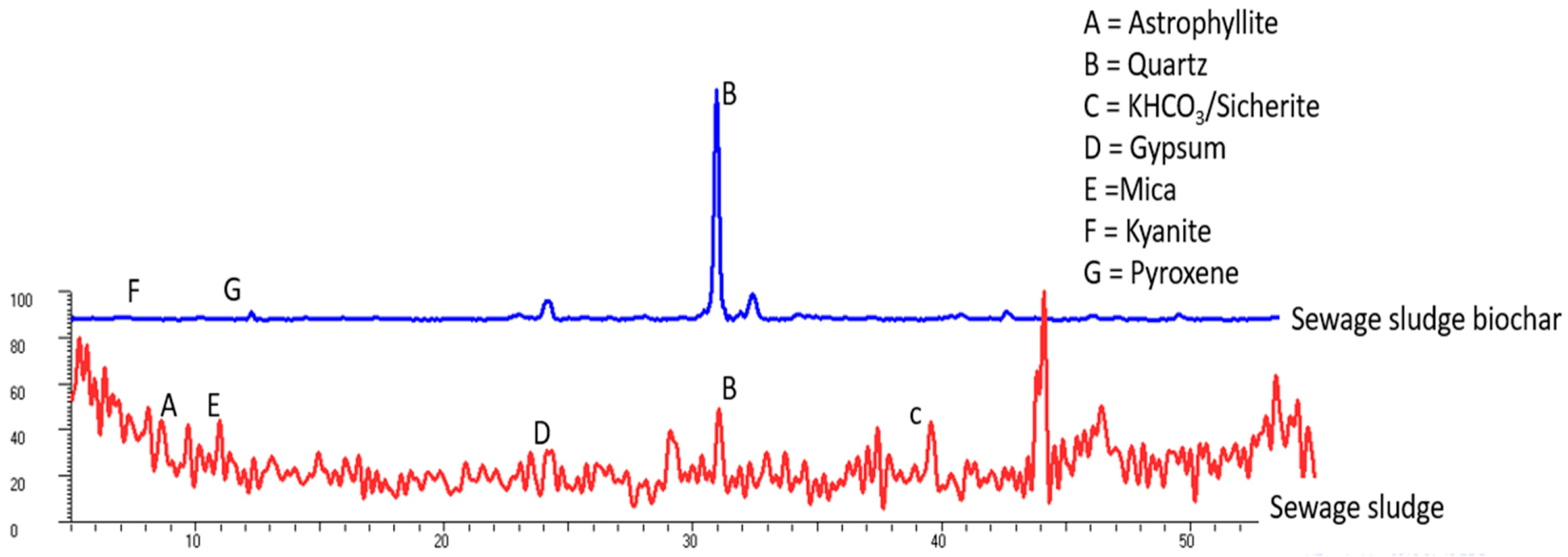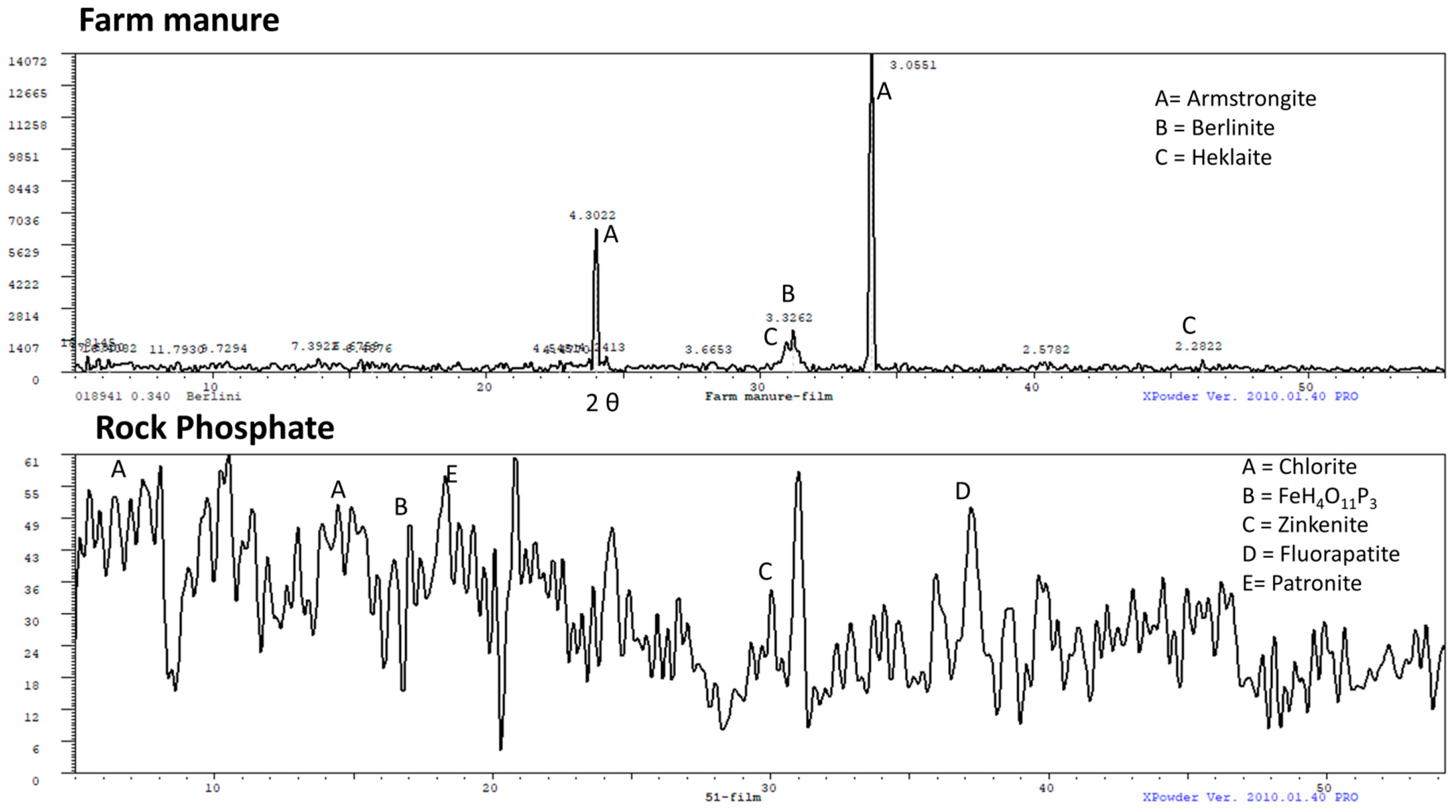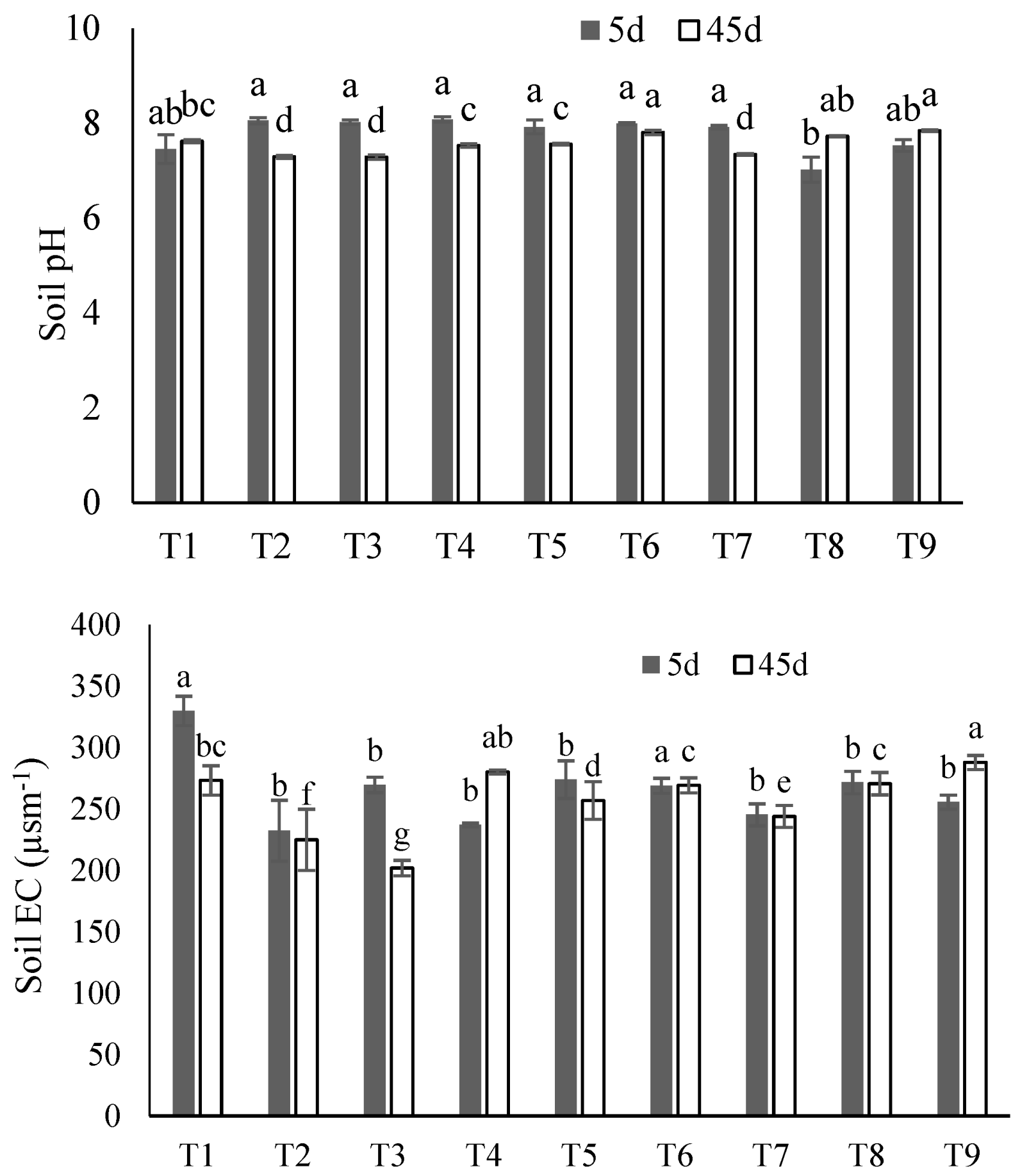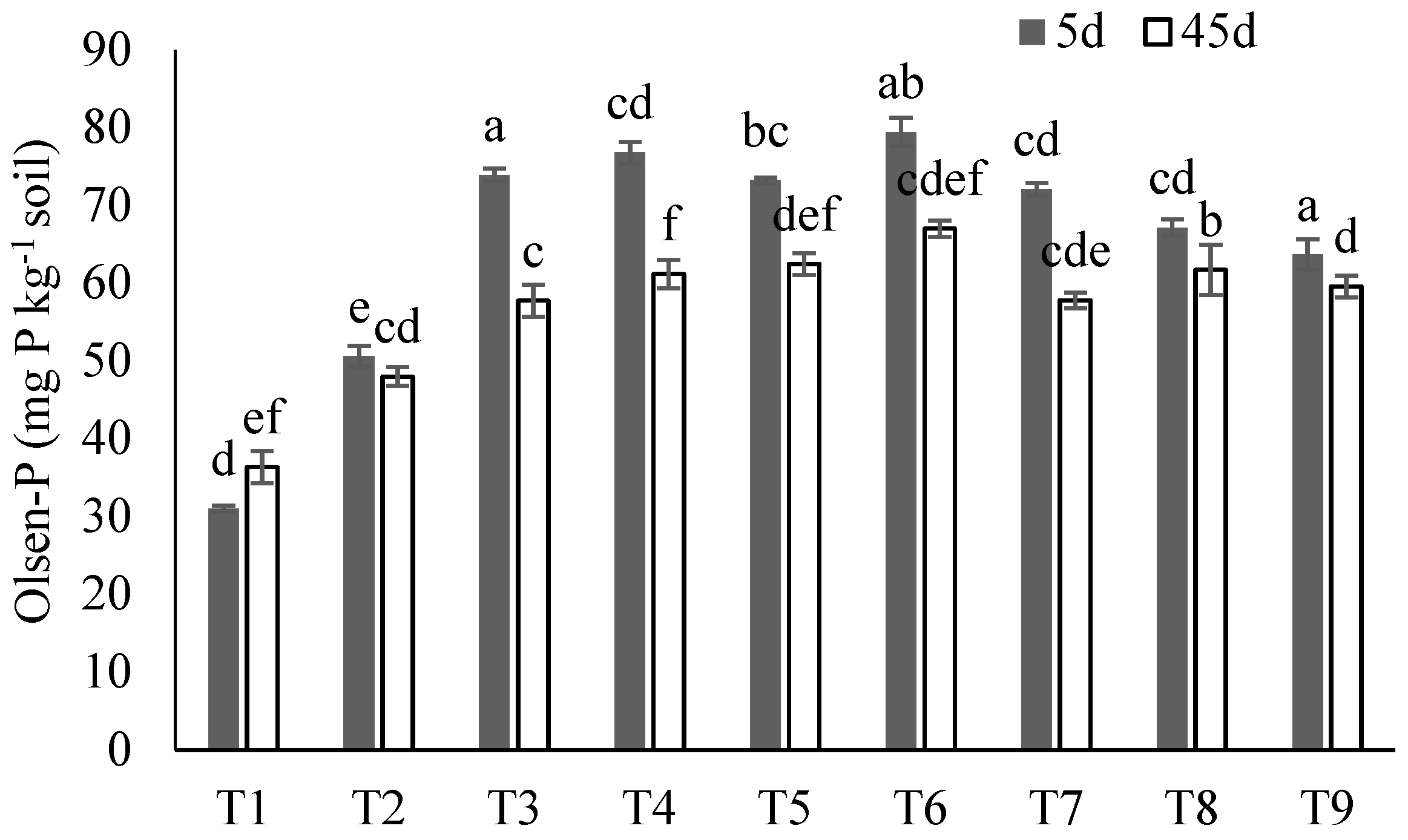The Sewage Sludge Biochar and Its Composts Influence the Phosphate Sorption in an Alkaline–Calcareous Soil
Abstract
1. Introduction
2. Material and Methods
2.1. Experimental Site
2.2. Experimental Inputs
2.3. Experimental Setup
2.4. Statistical Analyses
3. Results
3.1. Characterization of the SS, SS-BC, RP, FM, and Their Co-Composts
3.1.1. Nutrient Analysis of SS and SS-BC
3.1.2. Mineralogical Analysis of the Raw SS, SS-BC, RP, and FM Materials
3.1.3. FTIR Spectra of Co-Compost Materials
3.2. Soil pH and EC, and Olsen’s P
3.3. Sorption Parameters
4. Discussion
5. Conclusions
Supplementary Materials
Author Contributions
Funding
Institutional Review Board Statement
Informed Consent Statement
Data Availability Statement
Acknowledgments
Conflicts of Interest
References
- Gagnon, B.; Demers, I.; Ziadi, N.; Chantigny, M.H.; Parent, L.É.; Forge, T.A.; Larney, F.J.; Buckley, K.E. Forms of phosphorus in composts and in compostamended soils following incubation. Can. J. Soil Sci. 2012, 92, 711–721. [Google Scholar] [CrossRef]
- Daneshgar, S.; Callegari, A.; Capodaglio, A.G.; Vaccari, D. The potential phosphorus crisis: Resource conservation and possible escape technologies: A review. Resources 2018, 7, 37. [Google Scholar] [CrossRef]
- Lambers, H.; Bishop, J.G.; Hopper, S.D.; Laliberté, E.; Zúñiga-Feest, A. Phosphorus-mobilization ecosystem engineering: The roles of cluster roots and carboxylate exudation in young P-limited ecosystems. Ann. Bot. 2012, 110, 329–348. [Google Scholar] [CrossRef] [PubMed]
- Suriyagoda, L.; De Costa, W.A.J.M.; Lambers, H. Growth and phosphorus nutrition of rice when inorganic fertiliser application is partly replaced by straw under varying moisture availability in sandy and clay soils. Plant Soil 2014. [Google Scholar] [CrossRef]
- Barberis, E.; Ajmone Marsan, F.; Scalenghe, R.; Lammers, A.; Schwertmann, U.; Edwards, A.C.; Maguire, R.; Wilson, M.J.; Delgado, A.; Torrent, J. European soils overfertilized with phosphorus: Part 1. Basic properties. Fertil. Res. 1995, 45, 199–207. [Google Scholar] [CrossRef]
- Elser, J.J.; Bracken, M.E.S.; Cleland, E.E.; Gruner, D.S.; Harpole, W.S.; Hillebrand, H.; Ngai, J.T.; Seabloom, E.W.; Shurin, J.B.; Smith, J.E. Global analysis of nitrogen and phosphorus limitation of primary producers in freshwater, marine and terrestrial ecosystems. Ecol. Lett. 2007, 10, 1135–1142. [Google Scholar] [CrossRef]
- Faucon, M.P.; Houben, D.; Reynoird, J.P.; Mercadal-Dulaurent, A.M.; Armand, R.; Lambers, H. Advances and Perspectives to Improve the Phosphorus Availability in Cropping Systems for Agroecological Phosphorus Management; Elsevier Ltd.: Amsterdam, The Netherlands, 2015; Volume 134, ISBN 9780128033234. [Google Scholar]
- Han, J.; Ro, H.M. Interpreting competitive adsorption of arsenate and phosphate on nanosized iron (hydr)oxides: Effects of pH and surface loading. Environ. Sci. Pollut. Res. 2018, 25, 28572–28582. [Google Scholar] [CrossRef]
- von Wandruszka, R. Phosphorus retention in calcareous soils and the effect of organic matter on its mobility. Geochem. Trans. 2006. [Google Scholar] [CrossRef]
- Westermann, D.T. Lime Effects on Phosphorus Availability in a Calcareous Soil. Soil Sci. Soc. Am. J. 1992, 56, 489–494. [Google Scholar] [CrossRef]
- Vaccari, D.A.; Powers, S.M.; Liu, X. Demand-Driven Model for Global Phosphate Rock Suggests Paths for Phosphorus Sustainability. Environ. Sci. Technol. 2019, 53, 10417–10425. [Google Scholar] [CrossRef]
- Honvault, N.; Houben, D.; Nobile, C.; Firmin, S.; Lambers, H.; Faucon, M.-P. Tradeoffs among phosphorus-acquisition root traits of crop species for agroecological intensification. Plant Soil 2020. [Google Scholar] [CrossRef]
- DeLuca, T. Biochar effects on soil nutrient transformations. In Biochar for Environmental Management Science and Technology; Lehmann, J., Joseph, S., Eds.; Earthscan: London, UK, 2009; pp. 251–270. ISBN 978-1-84407-658-1. [Google Scholar]
- Cordell, D.; Rosemarin, A.; Schröder, J.J.; Smit, A.L. Towards global phosphorus security: A systems framework for phosphorus recovery and reuse options. Chemosphere 2011, 84, 747–758. [Google Scholar] [CrossRef]
- Tomei, M.C.; Stazi, V.; Daneshgar, S.; Capodaglio, A.G. Holistic approach to phosphorus recovery from urban wastewater: Enhanced biological removal combined with precipitation. Sustainability 2020, 12, 575. [Google Scholar] [CrossRef]
- Amann, A.; Zoboli, O.; Krampe, J.; Rechberger, H.; Zessner, M.; Egle, L. Environmental impacts of phosphorus recovery from municipal wastewater. Resour. Conserv. Recycl. 2018. [Google Scholar] [CrossRef]
- Daneshgar, S.; Buttafava, A.; Callegari, A.; Capodaglio, A.G. Economic and energetic assessment of different phosphorus recovery options from aerobic sludge. J. Clean. Prod. 2019, 223, 729–738. [Google Scholar] [CrossRef]
- Inguanzo, M.; Domínguez, A.; Menéndez, J.A.; Blanco, C.G.; Pis, J.J. On the pyrolysis of sewage sludge: The influence of pyrolysis conditions on solid, liquid and gas fractions. J. Anal. Appl. Pyrolysis 2002. [Google Scholar] [CrossRef]
- Cantrell, K.B.; Martin, J.H. Stochastic state-space temperature regulation of biochar production. Part I: Theoretical development. J. Sci. Food Agric. 2012, 92, 481–489. [Google Scholar] [CrossRef]
- Lehmann, J.; Joseph, S. Biochar for Environmental Management: Science and Technology; Routledge: Abingdon, UK, 2012; Volume 9781849770, ISBN 9781849770552. [Google Scholar]
- Muhmood, A.; Wu, S.; Lu, J.; Ajmal, Z.; Luo, H.; Dong, R. Nutrient recovery from anaerobically digested chicken slurry via struvite: Performance optimization and interactions with heavy metals and pathogens. Sci. Total Environ. 2018. [Google Scholar] [CrossRef]
- Bolognesi, S.; Bernardi, G.; Callegari, A.; Dondi, D.; Capodaglio, A.G. Biochar production from sewage sludge and microalgae mixtures: Properties, sustainability and possible role in circular economy. Biomass Convers. Biorefinery 2019. [Google Scholar] [CrossRef]
- Callegari, A.; Capodaglio, A.G. Properties and beneficial uses of (bio)chars, with special attention to products from sewage sludge pyrolysis. Resources 2018, 7, 20. [Google Scholar] [CrossRef]
- Racek, J.; Sevcik, J.; Komendova, R.; Kucerik, J.; Hlavinek, P. Heavy metal fixation in biochar after microwave pyrolysis of sewage sludge. Desalin. Water Treat. 2019, 159, 79–92. [Google Scholar] [CrossRef]
- Cope, C.O.; Webster, D.S.; Sabatini, D.A. Arsenate adsorption onto iron oxide amended rice husk char. Sci. Total Environ. 2014, 488–489, 554–561. [Google Scholar] [CrossRef] [PubMed]
- Daneshgar, S.; Vanrolleghem, P.A.; Vaneeckhaute, C.; Buttafava, A.; Capodaglio, A.G. Optimization of P compounds recovery from aerobic sludge by chemical modeling and response surface methodology combination. Sci. Total Environ. 2019, 668, 668–677. [Google Scholar] [CrossRef]
- Audette, Y.; O’Halloran, I.P.; Evans, L.J.; Martin, R.C.; Voroney, R.P. Kinetics of phosphorus forms applied as inorganic and organic amendments to a calcareous soil II: Effects of plant growth on plant available and uptake phosphorus. Geoderma 2016, 279, 70–76. [Google Scholar] [CrossRef]
- Haider, G.; Steffens, D.; Moser, G.; Müller, C.; Kammann, C.I. Biochar reduced nitrate leaching and improved soil moisture content without yield improvements in a four-year field study. Agric. Ecosyst. Environ. 2017, 237, 80–94. [Google Scholar] [CrossRef]
- Kahiluoto, H.; Kuisma, M.; Ketoja, E.; Salo, T.; Heikkinen, J. Phosphorus in manure and sewage sludge more recyclable than in soluble inorganic fertilizer. Environ. Sci. Technol. 2015, 49, 2115–2122. [Google Scholar] [CrossRef] [PubMed]
- Stutter, M.I. The composition, leaching, and sorption behavior of some alternative sources of phosphorus for soils. Ambio 2015, 44, 207–216. [Google Scholar] [CrossRef]
- Rehman, R.A.; Rizwan, M.; Qayyum, M.F.; Ali, S.; Zia-ur-Rehman, M.; Zafar-ul-Hye, M.; Hafeez, F.; Iqbal, M.F. Efficiency of various sewage sludges and their biochars in improving selected soil properties and growth of wheat (Triticum aestivum). J. Environ. Manag. 2018, 223, 607–613. [Google Scholar] [CrossRef]
- Sabiha-Javied; Mehmood, T.; Chaudhry, M.M.; Tufail, M.; Irfan, N. Heavy metal pollution from phosphate rock used for the production of fertilizer in Pakistan. Microchem. J. 2009, 91, 94–99. [Google Scholar] [CrossRef]
- Qayyum, M.F.; Abid, M.; Danish, S.; Saeed, M.K.; Ali, M.A. Effects of various biochars on seed germination and carbon mineralization in an alkaline soil. Pakistan J. Agric. Sci. 2014, 51, 977–982. [Google Scholar]
- Rehman, R.A.; Qayyum, M.F. Co-composts of sewage sludge, farm manure and rock phosphate can substitute phosphorus fertilizers in rice-wheat cropping system. J. Environ. Manag. 2020, 259. [Google Scholar] [CrossRef]
- Murphy, J.; Riley, J.P. A modified single solution method for the determination of phosphate in natural waters. Anal. Chim. Acta 1962, 27, 31–36. [Google Scholar] [CrossRef]
- IR Spectrum Table & Chart | Sigma-Aldrich. Available online: https://www.sigmaaldrich.com/technical-documents/articles/biology/ir-spectrum-table.html (accessed on 16 January 2021).
- Li, R.; Wang, J.J.; Zhang, Z.; Shen, F.; Zhang, G.; Qin, R.; Li, X.; Xiao, R. Nutrient transformations during composting of pig manure with bentonite. Bioresour. Technol. 2012, 121, 362–368. [Google Scholar] [CrossRef] [PubMed]
- Yu, H.; Zhao, Y.; Zhang, C.; Wei, D.; Wu, J.; Zhao, X.; Hao, J.; Wei, Z. Driving effects of minerals on humic acid formation during chicken manure composting: Emphasis on the carrier role of bacterial community. Bioresour. Technol. 2019, 294, 122239. [Google Scholar] [CrossRef]
- Praspaliauskas, M.; Pedišius, N.; Striuigas, N. Elemental Migration and Transformation from Sewage Sludge to Residual Products during the Pyrolysis Process. Energy Fuels 2018. [Google Scholar] [CrossRef]
- Karim, A.A.; Kumar, M.; Singh, S.K.; Panda, C.R.; Mishra, B.K. Potassium enriched biochar production by thermal plasma processing of banana peduncle for soil application. J. Anal. Appl. Pyrolysis 2017, 123, 165–172. [Google Scholar] [CrossRef]
- Song, X.D.; Xue, X.Y.; Chen, D.Z.; He, P.J.; Dai, X.H. Application of biochar from sewage sludge to plant cultivation: Influence of pyrolysis temperature and biochar-to-soil ratio on yield and heavy metal accumulation. Chemosphere 2014, 109, 213–220. [Google Scholar] [CrossRef]
- Xu, J.; Xu, X.; Liu, Y.; Li, H.; Liu, H. Effect of microbiological inoculants DN-1 on lignocellulose degradation during co-composting of cattle manure with rice straw monitored by FTIR and SEM. Environ. Prog. Sustain. Energy 2016, 35, 345–351. [Google Scholar] [CrossRef]
- Qayyum, M.F.; Abdullah, M.A.; Rizwan, M.; Haider, G.; Ali, M.A.; Zafar-ul-Hye, M.; Abid, M. Different nitrogen and biochar sources’ application in an alkaline calcareous soil improved the maize yield and soil nitrogen retention. Arab. J. Geosci. 2019, 12, 664. [Google Scholar] [CrossRef]
- Efthymiou, A.; Grønlund, M.; Müller-Stöver, D.S.; Jakobsen, I. Augmentation of the phosphorus fertilizer value of biochar by inoculation of wheat with selected Penicillium strains. Soil Biol. Biochem. 2018, 116, 139–147. [Google Scholar] [CrossRef]
- Biswas, D.R.; Narayanasamy, G. Rock phosphate enriched compost: An approach to improve low-grade Indian rock phosphate. Bioresour. Technol. 2006, 97, 2243–2251. [Google Scholar] [CrossRef] [PubMed]
- Guo, B.; Liang, Y.; Li, Z.; Han, F. Phosphorus adsorption and bioavailability in a paddy soil amended with pig manure compost and decaying rice straw. Commun. Soil Sci. Plant Anal. 2009, 40, 2185–2199. [Google Scholar] [CrossRef]
- Dao, T.H.; Sikora, L.J.; Hamasaki, A.; Chaney, R.L. Manure Phosphorus Extractability as Affected by Aluminum- and Iron By-Products and Aerobic Composting. J. Environ. Qual. 2001, 30, 1693–1698. [Google Scholar] [CrossRef] [PubMed]
- Nishanth, D.; Biswas, D.R. Kinetics of phosphorus and potassium release from rock phosphate and waste mica enriched compost and their effect on yield and nutrient uptake by wheat (Triticum aestivum). Bioresour. Technol. 2008, 99, 3342–3353. [Google Scholar] [CrossRef] [PubMed]
- Morales, M.M.; Comerford, N.; Guerrini, I.A.; Falcão, N.P.S.; Reeves, J.B. Sorption and desorption of phosphate on biochar and biochar-soil mixtures. Soil Use Manag. 2013, 29, 306–314. [Google Scholar] [CrossRef]





| Sample Code | Treatment | Composition of Composted Material (%) | |||
|---|---|---|---|---|---|
| SS | SS-BC | FM | RP | ||
| T1 | Control | - | - | - | - |
| T2 | SS | 100 | - | - | - |
| T3 | SS-BC | - | 100 | - | - |
| T4 | SS50:FM50 | 50 | - | 50 | - |
| T5 | SS75:FM25 | 75 | - | 25 | - |
| T6 | SS25:FM25:RP50 | 25 | - | 25 | 50 |
| T7 | SS50:FM25:RP25 | 50 | - | 25 | 25 |
| T8 | SS75:RP25 | 75 | - | - | 25 |
| T9 | SS50:RP50 | 50 | - | - | 50 |
| 5 d | 45 d | |||||
|---|---|---|---|---|---|---|
| Treatments | k | Smax | R2 | k | Smax | R2 |
| Control | 0.06(ab) ± 0.0 | 540.61(c) ± 3.67 | 0.99(a) ± 0.01 | 0.04(a) ± 0.00 | 582.59(bc) ± 5.27 | 0.93(a) ± 0.01 |
| T2 (SS) | 0.12(ab) ± 0.03 | 887.04(abc) ± 110.15 | 0.91(a) ± 0.05 | 0.12(a) ± 0.11 | 189.85 (c) ± 189.15 | 0.84(a) ± 0.08 |
| T3 (SS-BC) | 0.18(ab) ± 0.04 | 756.59(bc) ± 97.16 | 1.00(a) ± 0.00 | 0.06(a) ± 0.05 | 272.59 (c) ±272.44 | 0.94(a) ± 0.02 |
| T4 (SS50:FM50) | 0.25(a) ± 0.12 | 606.48(bc) ± 76.69 | 0.98(a) ± 0.01 | 0.06(a) ± 0.03 | 248.61(c) ± 248.39 | 0.82(a) ± 0.09 |
| T5 (SS75:FM25) | 0.05(ab) ± 0.00 | 668.75(bc) ± 9.77 | 0.70(a) ± 0.08 | 0.08(a) ± 0.01 | 648.03(bc) ± 18.81 | 0.92(a) ± 0.02 |
| T6 (SS25:FM25:RP50) | 0.04(a) ± 0.01 | 1288.22(a) ± 271.02 | 0.66(a) ± 0.20 | 0.02(a) ± 0.00 | 1531.79(a) ± 36.86 | 0.66(b) ± 0.03 |
| T7 (SS50:FM25:RP25) | 0.05(ab) ± 0.00 | 988.06(abc) ± 37.73 | 0.87(a) ± 0.01 | 0.06(a) ± 0.00 | 860.77(abc) ± 12.69 | 0.919(a) ± 0.03 |
| T8 (SS75:FM0:RP25) | 0.11(ab) ± 0.00 | 1018.46(abc) ± 23.39 | 0.96(a) ± 0.00 | 0.099(a) ± 0.00 | 1062.37(ab) ± 18.10 | 0.97(a) ± 0.01 |
| T9 (SS50:FM0:RP50) | 0.10(ab) ± 0.00 | 1073.54(ab) ± 22.31 | 0.96(a) ± 0.00 | 0.08(a) ± 0.00 | 1178.58(ab) ± 13.79 | 0.92(a) ± 0.03 |
| 5 d | 45 d | |||||
|---|---|---|---|---|---|---|
| Treatments | Intercept | Slope | R2 | Intercept | Slope | R2 |
| Control | 0.30(c) ± 0.03 | 0.64(a) ± 0.01 | 0.96(a) ± 0.00 | 0.23(e) ± 0.02 | 0.73(a) ± 0.01 | 0.95(ab) ± 0.00 |
| T2 (SS) | 1.54(ab) ± 0.15 | 0.36(d) ± 0.05 | 0.91(abc) ± 0.03 | 2.03(a) ± 0.02 | 0.19(f) ± 0.00 | 0.90(abc) ± 0.01 |
| T3 (SS-BC) | 1.63(a) ± 0.15 | 0.27(d) ± 0.06 | 0.90(ab) ± 0.04 | 1.88(ab) ± 0.01 | 0.27(ef) ± 0.00 | 0.95(ab) ± 0.01 |
| T4 (SS50:FM50) | 1.60(ab) ± 0.24 | 0.31(cd) ± 0.08 | 0.81(abc) ± 0.10 | 1.36(c) ± 0.23 | 0.39(ed) ± 0.07 | 0.92(abc) ± 0.03 |
| T5 (SS75:FM25) | 1.09(a) ± 0.05 | 0.42(bcd) ± 0.02 | 0.82(c) ± 0.04 | 1.38(bc) ± 0.13 | 0.35(de) ± 0.03 | 0.85(c) ± 0.03 |
| T6 (SS25:FM25:RP50) | 0.75(bc) ± 0.11 | 0.58(ab) ± 0.03 | 0.83(bc) ± 0.04 | 0.64(d) ± 0.03 | 0.60(b) ± 0.01 | 0.71(d) ± 0.02 |
| T7 (SS50:FM25:RP25) | 0.91(b) ± 0.08 | 0.52(abc) ± 0.02 | 0.87(abc) ± 0.01 | 1.08(cd) ± 0.02 | 0.47(cd) ± 0.01 | 0.87(bc) ± 0.02 |
| T8 (SS75:FM0:RP25) | 1.10(b) ± 0.03 | 0.52(abc) ± 0.00 | 0.96(a) ± 0.00 | 0.97(cd) ± 0.03 | 0.56(bc) ± 0.01 | 0.97(a) ± 0.01 |
| T9 (SS50:FM0:RP50) | 1.00(bc) ± 0.02 | 0.56(a) ± 0.00 | 0.97(a) ± 0.00 | 0.80(d) ± 0.08 | 0.62(ab) ± 0.02 | 0.97(ab) ± 0.01 |
Publisher’s Note: MDPI stays neutral with regard to jurisdictional claims in published maps and institutional affiliations. |
© 2021 by the authors. Licensee MDPI, Basel, Switzerland. This article is an open access article distributed under the terms and conditions of the Creative Commons Attribution (CC BY) license (http://creativecommons.org/licenses/by/4.0/).
Share and Cite
Rehman, R.A.; Qayyum, M.F.; Haider, G.; Schofield, K.; Abid, M.; Rizwan, M.; Ali, S. The Sewage Sludge Biochar and Its Composts Influence the Phosphate Sorption in an Alkaline–Calcareous Soil. Sustainability 2021, 13, 1779. https://doi.org/10.3390/su13041779
Rehman RA, Qayyum MF, Haider G, Schofield K, Abid M, Rizwan M, Ali S. The Sewage Sludge Biochar and Its Composts Influence the Phosphate Sorption in an Alkaline–Calcareous Soil. Sustainability. 2021; 13(4):1779. https://doi.org/10.3390/su13041779
Chicago/Turabian StyleRehman, Rabia Abdur, Muhammad Farooq Qayyum, Ghulam Haider, Kate Schofield, Muhammad Abid, Muhammad Rizwan, and Shafaqat Ali. 2021. "The Sewage Sludge Biochar and Its Composts Influence the Phosphate Sorption in an Alkaline–Calcareous Soil" Sustainability 13, no. 4: 1779. https://doi.org/10.3390/su13041779
APA StyleRehman, R. A., Qayyum, M. F., Haider, G., Schofield, K., Abid, M., Rizwan, M., & Ali, S. (2021). The Sewage Sludge Biochar and Its Composts Influence the Phosphate Sorption in an Alkaline–Calcareous Soil. Sustainability, 13(4), 1779. https://doi.org/10.3390/su13041779









